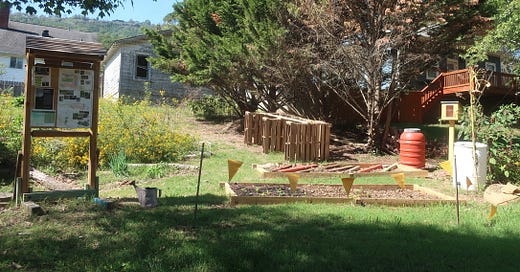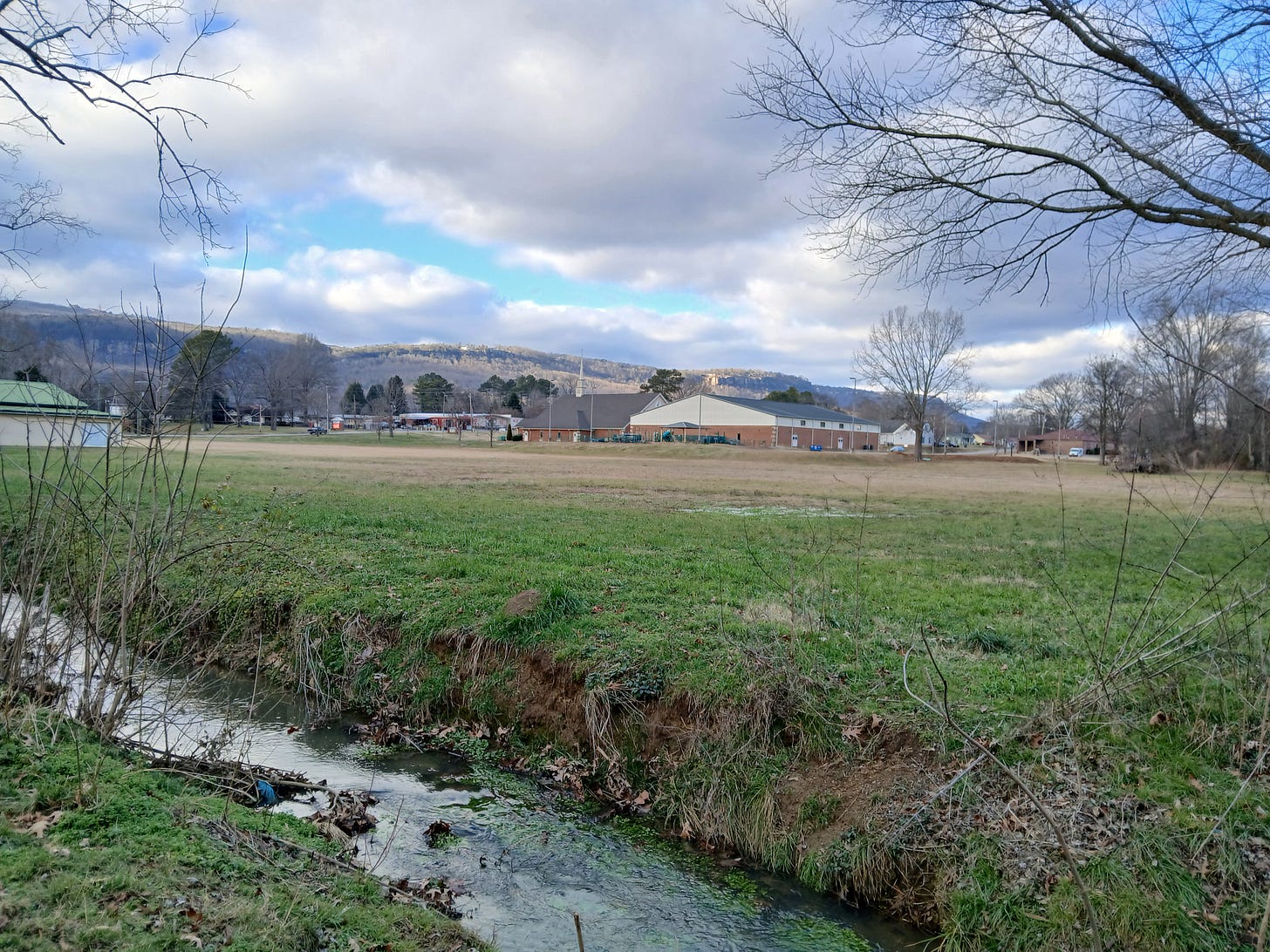As I write the Chattanooga region still lies under a (fraying, and liable to disappear later today) blanket of snow, ice clings to the bluffs, and the sky is steely gray. Yet spring is not too far off—the first spring ephemerals will begin blooming next month, the buds of trees will begin to swell with the promise of flowers and leaves subsequent, the daffodils and other bulb plants will pop up. Tree planting, tending, mulching; seed starting, seedling nurturing, and then planting; garden planning, building, and forging contacts and strengthening networks of participants. As we at the Food Forest Coalition of Chattanooga look forward to a new spring—our second!—we do so with an expanded vision and footprint of activity, one that can integrate many more people in communities across Chattanooga and in the city’s immediate hinterland. In what follows I will briefly profile all of our partner sites and the particular goals, needs, and possibilities that each has. If you see a site that resonated with your own skills, interests, and so forth, or is just geographically close to where you live (the most ideal scenario), please get in touch with me, either via email (jallen22@umd.edu) or through one of our social media presences (Instagram or Bluesky), and I can direct you to the relevant people involved. We will also be doing work days and orientation at various locations, some of which we’ve already got scheduled and will be noted here.
St. Elmo United Methodist Church Community Food Forest
Our inaugural site, with trees and other perennials that will be entering their second year of growth here, this community food forest could use neighborhood-based volunteers who can make small regular interventions as we continue to expand the plantings and maintain what is already growing. There is also potential to join in on the wider re-landscaping initiative the church is undertaking, seeking to make a more ecologically appropriate and environmentally sustainable footprint surrounding the church structure. If you’re interested in participating here, there will be a new and returning volunteer and site steward orientation on February 15 from 10:30 am to 12 at the food forest site (if we have inclement weather we can retreat indoors to the church itself).
Ella Library Community Garden and Food Forest
Another of our earliest sites, the Ella “pocket” food forest still has some room for expansion, as does the nascent community garden we are establishing this spring. Volunteers and other participants who are bi- or tri-lingual (many users of the garden speak both Spanish and a Mayan language) would be especially helpful here. We have two volunteer events scheduled for Ella so far, and a third planned but not yet on the calendar: on January 25th we will have a volunteer work day to build out the garden infrastructure and prep beds for spring, while on March 15 the library will be acting as a pick-up site for Tennessee Tree Day; we’ll probably also be doing a community garden kick-off to coincide with tree pick-up and will have literature and other resources on hand for home tree planting, more info to come closer to the event.
Emma Wheeler Homes Community Garden and Food Forest
At Emma Wheeler Homes we have several objectives for this growing season: one, to expand participation in and the productivity of the community garden, recruiting more gardeners to adopt and manage their own plots; two, to finish planting the community food forest surrounding the garden, adding some social infrastructure as well (tool shed, gazebo, perhaps something for outdoor cooking); and three, exploring options for a community farm and agroforestry component in the currently empty space beyond the community garden complex. Volunteers with experience managing community garden spaces would be especially helpful here; anyone interested in larger-scale farming and community agriculture at scale could be of use here as well as Chattanooga Valley and Ascension Lutheran (see below). We do not currently have any public volunteer events planned but will update once we do; at some point in March or April we will have a big community kick-off event.
Southside Community Center Food Forest
Lying between St. Elmo and Alton Park, the space behind the community center is being transformed into a food forest, and has seen a great deal of expansion just over the last few months. Regular volunteers, especially in the summer, would be helpful in basic maintenance; we’d also like to build out the steward and educational base there, given that the site has a lot of foot-traffic in and out of the community center and hence a lot of potential for public outreach. Static educational infrastructure is an especial need here.
Community Food Forest at Rockmont Park
Right at the edge of St. Elmo, this new community food forest is part of the Lookout Mountain Conservancy’s publicly accessible land that includes the Old Wauhatchie Boulders; it might be the most scenic of any of our affiliated locations! While the LMC has taken the central role in managing it there is definitely room for community volunteers and additional stewards, particularly people who either live in the immediate neighborhood or who frequent the site (such as rock-climbers). Initial fruit tree plantings went in last year, with room for additional expansion, perennial groundcover plantings, as well as additional planned infrastructure.
Clifton Hills School Garden
This site is a bit different from our other partners in that it is currently entirely located within school grounds and hence is not generally publicly accessible. However, we have hosted some public work days previously and will almost certainly have others in the future. The garden—which has flourished over the last little less than a year—provides educational and food opportunities for the students, teachers, and associated parents at the elementary school, which primarily serves children of Guatemalan background (this is another good opportunity for volunteers fluent in Spanish and English). We have also drafted plans for an extensive community food forest that would lie outside of school grounds proper and be publicly accessible, but are still waiting on official approval, itself pending finalization of renovation plans for the school.
Ascension Lutheran Church Community Garden
Located in East Ridge, this is a new community garden that got its start last year; a neighbor with extensive gardening experience who could act as a regular advisor would be especially helpful here. There is also potential which we will be exploring in coming months for a community food forest linked into the garden, akin to what we’ve been developing at Emma Wheeler; the larger property also has potential for a larger-scale community farm and agroforestry complex, something else we are exploring.
Westside Community Garden, Greenhouse, and Orchard
Westside Community Garden is, as far as I can tell, the oldest community garden in Chattanooga, dating back to 1986. It is also threatened with destruction or diminishment via the Westside Development Plan, something that we will be monitoring over coming months and hopefully working with the city in ensuring the site’s future, even if somewhat modified. We would also like to route some volunteers and expertise to the site, to help expand the gardener base back to where it once was, and to ensure that the greenhouse on the site—an incredible resource in itself—is fully utilized and managed. There is also a gorgeous little orchard attached to the garden that could use some fresh attention, for which I expect we’ll do a community work day in the near future. We’ll be putting together a regular schedule of volunteer opportunities at this site, so stay tuned.
Chattanooga Valley Church of the Nazarene Community Agriculture Project
This is currently an undeveloped location, but one with a great deal of potential, lying in Flintstone, Georgia, about five minutes south of the Tennessee state line so very accessible to both Walker County and to South Chattanooga. The church currently hosts a robust community assistance program, focusing in particular upon food security; the church also has several acres of land available for community agriculture projects. We’ll be working out the details over coming months, but if you are looking for a potentially large project with which to be involved, this might well be it. The community there would like to start out with a community garden and fruit tree component initially, but there is potential for a community farm, chicken coop, orchards, and other possibilities.






